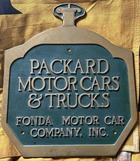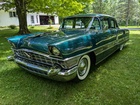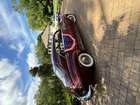|
Re: Loud clicking from my '52
|
||||
|---|---|---|---|---|
|
Home away from home
|
I dropped the pan when I did the lifters a few weeks ago, just to seal the engine (the crank is not striking the pan - checked for that). The pan was very clean, no gunk at all. Additionally, the lifter galleys were also very clean.
I believe the engine was rebuild in 2012 because I found the car listed in an auction at that time (long before I bought it) which said it had been freshly rebuilt. Doesn't really mean it is true but I believe it because of the condition of the engine I have noted in anything I have done to it sense. Based on the auction description at the time, there are only about 4,000 miles on the car, including my own, since the rebuild. I have a mechanical oil gauge under the hood along with the warning light in the dash. Oil pressure at idle is just at 30 lbs., which seems good. It only increases to about 35-38 under acceleration though, and I would generally expect more variance. But it seems sufficient. Since this developed, I have tried running Rislone, which has not helped. Originally I thought this might be that a valve was hitting the head, because I did not check the clearance between the two when I replaced the lifters since I did not change or re-seat any valves, and I lacked the tool to do the measurement. But, with compression between 100 and 105 across all eight cylinders, I don't think this could be the issue. What I find confusing is that the noise is not present when the engine is cold. I would generally think most things that cause ticking or knocking in the engine (like bearings or wrist pins) would be more noticable when cold, rather than when things heat up and expand. I really feel it is in the valve train. Is it safe to take a feeler gauge or a step gauge, maybe at .003 or .005 and insert between the valves and lifters with the engine running (and ticking), to see if it eliminates or lessens the ticking at one of the valves? I did pull the valve covers and did not notice that the tick was substantially louder, but the whole area is hard to get to without taking out the heater, etc. I am also wondering what a cam bearing might sound like when failing.
Posted on: 2018/10/23 23:43
|
|||
|
1941 Touring Sedan
1952 250 Convertible 1932 902 Rumble seat Coupe  Who is John Galt? Who is John Galt?
|
||||
|
||||
|
Loud clicking from my '52
|
||||
|---|---|---|---|---|
|
Home away from home
|
I recently replaced the hydralic units in my lifters for my 52 Convertible. The units I used are new manufactured units. I used to have a quiet tick after the car got up to full operating temperature.
After I finished, I had no noise for a few weeks, but it ran a little hot, so i did not drive a whole lot. The heat issue was addressed and I drove it for a couple hour long drives. The car was very quiet and ran great. About a week ago, after a long drive, I noticed a very loud ticking noise, which sounded like a lifter to me. Once the car cooled down, there was no noise. When I start the car, there is no noticable noise, but after about 10 - 15 minutes, again the (very) loud ticking. Seems to go away under acceleration and higher RPMs. Comes back as soon as the RPMs decrease. I have pulled the belt with no change, so i can rule out the generator and water pump. I switched out the fuel pump with no change. Pulling individual plug wires does no affect the frequency or pitch. I pulled the valve covers and can see each valve moving, but I do not know if they are moving enough. I can see that all the keepers are in place and all the springs look good.Compression test is good across all eight cylinders, so I am assuming no bent valves. At the time I did the lifters, the valve guides seemed good. Sounds very high up in the engine to me, like it should be valve train, but with new hydralics, I don't see how it can be. I don't think I can attach a sound file (just tried - can't). If it is not valve train, then I think maybe wrist pin, only because it does not sound low enough to be a rod bearing. Any ideas on how to narrow this down?
Posted on: 2018/10/23 19:16
|
|||
|
1941 Touring Sedan
1952 250 Convertible 1932 902 Rumble seat Coupe  Who is John Galt? Who is John Galt?
|
||||
|
||||
|
Re: Running very hot
|
||||
|---|---|---|---|---|
|
Home away from home
|
I can see my screen name here keeps adding confusion.
I am working on my '52 250. It originally called for a 7 lb cap, but in a subsequent service bulletin, that was raised to 13 lb, if needed. I have always run a 7 lb. cap. My next step is still to flush the radiator and the block. I was planning to do them together, but I might pull the radiator to flush it more thoroughly. That would let me do a gravity flow test before and after.
Posted on: 2018/9/17 1:03
|
|||
|
1941 Touring Sedan
1952 250 Convertible 1932 902 Rumble seat Coupe  Who is John Galt? Who is John Galt?
|
||||
|
||||
|
Re: Running very hot
|
||||
|---|---|---|---|---|
|
Home away from home
|
Yes, new coolant added at about 50/50 - I think it might have been just a little light because I bought 2 gallons of coolant + added some left over in a container. Capacity is just under 20 Qts, so I might be just a little under 50/50, but would be quite close.
One thing I noted this morning. I parked the car a few days ago after running it to temperature. I have a 7Lb cap on the radiator. After running, the system was pressurized, but not enough to cause the overflow to leak. But the top and bottom hoses were definately hard from being pressurized. This morning, the system (at cold) was still under pressure, maybe not as much, but the hoses were still hard and I had to release the cap slowly to bleed out the pressure. I am having a hard time figuring this out. At temperature the coolant/water solution expends and builds up pressure in the system. When it cools, it should contract back down. I am not sure why there would still be significant pressure in the system when the water certainly got down to 60 or below in the last few nights. In the past, after cooling down, my top radiator hose would be noticeably concave at the top. I replaced both top and bottom hoses, they are clearly not contracting during operation as both get quite hard from the internal pressure. But why would they remain presurized after the water cools back down. I am pretty certain no water is leaving the system based on the level in the radiator.
Posted on: 2018/9/16 17:06
|
|||
|
1941 Touring Sedan
1952 250 Convertible 1932 902 Rumble seat Coupe  Who is John Galt? Who is John Galt?
|
||||
|
||||
|
Re: Running very hot
|
||||
|---|---|---|---|---|
|
Home away from home
|
I'll go with the flush before replacing the water pump.
My parts store has nothing with oxalic acid in it. But, I do find wood bleach at my hardware store that seems like what I want. I have found a couple places on line that say to use about 16 Oz. in my system (filled with water, not coolant) run it to temp for a while, then drain and refill with clear water and about 1/4 cup of sodium carbonate (not sure where to find that yet) and run to temperature to neutralize the acid. Drain that and refill with 50/50 mix of water to coolant. Hopefully, this will address the issue. Certainly worth a try...
Posted on: 2018/9/15 17:52
|
|||
|
1941 Touring Sedan
1952 250 Convertible 1932 902 Rumble seat Coupe  Who is John Galt? Who is John Galt?
|
||||
|
||||
|
Re: Running very hot
|
||||
|---|---|---|---|---|
|
Home away from home
|
Since I replaced the head gasket, so I suppose it is possible that there could be some lack of seal, but it seems unlikely. I did do a compression test in which all cylinders were between 110 - 120. I am not sure any leak between cylinders would show in this test either, unless it was truly significant. There is no other indication of any head gasket problems, no contaminated oil or radiator water. I do get a small amount of water coming out the tail pipe on start up after a few days, which I don't remember from before on this car, but I believe it to be condensation. It seems like a leak down test might be the way to go before I pull the head, which would probably be close to the bottom of my list of things to do.
I did replace the thermostat and am finding now that all is good as long as I am moving. If I stop at a light, I can see the guage begin to climb (again, we are talking 70 degree weather). It will come back down as I get back up to speed. I think my next step is to flush the block and to re-install my old water pump.
Posted on: 2018/9/14 13:12
|
|||
|
1941 Touring Sedan
1952 250 Convertible 1932 902 Rumble seat Coupe  Who is John Galt? Who is John Galt?
|
||||
|
||||
|
Re: Running very hot
|
||||
|---|---|---|---|---|
|
Home away from home
|
Tom, I have re-torqued the head several times now. The last Time required very little torquing, the first time (which was only after letting it get up to temperature for a while in the garage) quite a bit. I am not really certain how often I should do this, but my sense is until it doesn't need it an longer. The torque is not high, I think it was 60 lbs.
Posted on: 2018/9/12 14:45
|
|||
|
1941 Touring Sedan
1952 250 Convertible 1932 902 Rumble seat Coupe  Who is John Galt? Who is John Galt?
|
||||
|
||||
|
Re: Running very hot
|
||||
|---|---|---|---|---|
|
Home away from home
|
I was at the garage this AM and let the car idle quite a while to get to temperature. I used a radiator thermometer and my hand help temp gauge.
One thing I noticed is that the car comes up to temperature very slowly, and the radiator seems to keep pace. Even before the thermostat should open - say 145 - 150 degrees, the radiator is at a similar temp - maybe a little less, but not appreciably. I noted no difference when the car finally hit 160 degrees, and the top radiator hose was probably only about 110 degrees. I could not feel and water running through, but the radiator was at similar temp. I could not see water moving in the radiator as the thermostat opens, which I assume I would, but the water does churn (and gets heat from somewhere). Finally got to 180 degrees and saw the same situation. The upper hose never got very hot, but the radiator did get to about 170. I am assuming the radiator is getting heat exchange through the lower hose, but even at 180, the lower hose, the lower part of the radiator and the pump itself are all only around 150 degrees. The top is hotter. I do not know what temp the thermostat is, but it is the older style with the bug spring. I do have a 160 degree one to install. The exhaust manifolds would reach around 380 degrees, but the intake remained fairly cool at around 130 or so.
Posted on: 2018/9/10 13:56
|
|||
|
1941 Touring Sedan
1952 250 Convertible 1932 902 Rumble seat Coupe  Who is John Galt? Who is John Galt?
|
||||
|
||||
|
Re: Running very hot
|
||||
|---|---|---|---|---|
|
Home away from home
|
Owen D - your observation on exhaust restriction is interesting, and not in a good way. When rebuilding the heat riser, I was unable to get the weight for the heat riser to be at 6 o'clock when opened. Best I could do was about 11 0'clock closed (or diverted to the intake) and about 7/8 o'clock opened, or undiverted. I posted a subject on that a few weeks ago. It is now exactly as the one in my '41 (which is to say that undiverted is around 7/8 o'clock), which seems to work. There are a few pictures, but I don't know how to cross reference them here. When this (overheating) started, I removed the spring from the post, allowing the weight to fall to full open at all times. I don't see how this is restrictive, but it is an area that I believe is different from before. I think the shaft is slighty different in the rebuild kit, but maybe I put the flap in totally wrong. Can you look at that post and see if it looks OK to your eye? I show pix of both diverted and undiverted.
If anyone has a good picture or diagram of how this (heat riser) goes together, I would really appreciate it. Arthur C - I am not sure I follow your comment here. Are you thinking the water pump is pulling hard enough to collapse the intake hose? I will look at this when hot, but the system is a 7 lb system and generally the hoses are under pressure when everything gets hot. The bottom hose is new (actually all are) . The only sign I get of collapse is when the car cools down, the top hose shows a small amount of contraction, i think from the displacement as the water contracts to normal temp. This was also the case before the rebuild. PTV - The engine is timed at 6 BTC, per the manual, and I can see a good amount of additional advance when I accelerate. Also, the timing is confirmed by my vacuum gauge and i have good power throughout the driving curve, so I believe it is right on. It is a great suggestion, I have a Plymouth flathead that is very sensitive to timing and will run hot when it is off, so this is an area I have looked at closely. The vacuum unit is the same as when I began. Jim - yes, I am assuming that I did something wrong or caused an issue, so I am trying to think through what the potential causes are. I can eventually get all the way back to the head gasket, but I don't think that is where the issue is. I'll try to easy stuff first - flushing the system, thermostat and then I'll put the old water pump back on. I was not aware it was going bad until I removed it and saw traces of rust from the weep hole and on the balancer. But you are right - I need to think through everything I did as the problem did not exist before. BTW - this is my '52 I am working on - no louvers. This gives me a few new tings to look at. Thanks to all for taking the time to help.
Posted on: 2018/9/10 11:24
|
|||
|
1941 Touring Sedan
1952 250 Convertible 1932 902 Rumble seat Coupe  Who is John Galt? Who is John Galt?
|
||||
|
||||








